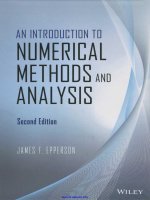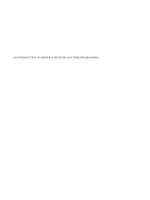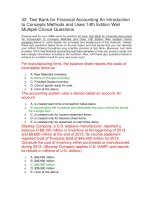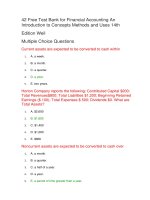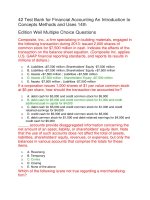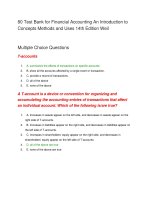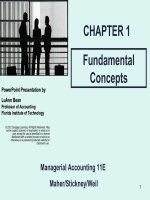Financial accounting an introduction to concepts methods and uses 14th edition weil test bank
Bạn đang xem bản rút gọn của tài liệu. Xem và tải ngay bản đầy đủ của tài liệu tại đây (427.71 KB, 65 trang )
Chapter 2: The Basics of Record Keeping and Financial
Statement Preparation: Balance Sheet
Student: ___________________________________________________________________________
1. The T-account looks like the letter T, with a horizontal line bisected by a vertical line. Increases in
shareholders’ equity appear on the right side, and decreases in shareholders’ equity appear on the left side of
T-accounts.
True False
2. The T-account looks like the letter T, with a horizontal line bisected by a vertical line. Increases in liabilities
appear on the right side, and decreases in liabilities appear on the left side of T-accounts.
True False
3. The T-account looks like the letter T, with a horizontal line bisected by a vertical line. Increases in assets
appear on the left side, and decreases in assets appear on the right side of T-accounts.
True False
4. A T-account is a device or convention for organizing and accumulating the accounting entries of transactions
that affect an individual account, such as cash, accounts receivable, bonds payable, or additional paid-in
capital.
True False
5. The balance sheet equation maintains equality by reporting the financial statement effects of each event and
transaction in a dual manner, or what are termed the dual effects of transactions.
True False
6. The balance sheet equation shows the equality of assets with liabilities plus shareholders’ equity. This
equation requires that an entity’s assets exactly balance, or offset, an equal amount of financing provided by
creditors and owners of the corporation.
True False
7. The balance sheet equation underlies the recording of transactions and events. It captures the financial
statement effects of operating, investing, and financing transactions—three key activities of business firms.
True False
8. The balance sheet equation provides the analytical framework to understand the effects of transactions and
events on the financial statements.
True False
9. The balance sheet groups individual accounts by type (asset, liability, or shareholders’ equity) and lists these
accounts with their balances as of the balance sheet date.
True False
10. The date of the balance sheet appears at the bottom of the balance sheet.
True False
11. The asset and liability categories group individual accounts by the expected timing of cash receipts (for
assets) or cash payments (for liabilities).
True False
12. If the firm expects to collect or pay more than one year after the balance sheet date, the balance sheet
classifies these as noncurrent assets and noncurrent liabilities, respectively.
True False
13. The balance sheet begins with a list of assets and then lists liabilities and shareholders’ equity.
True False
14. Both U.S. GAAP and IFRS require firms to report balance sheet accounts for the prior year in addition to
the current year.
True False
15. Under U.S. GAAP, assets and liabilities in the balance sheet appear in order of increasing
closeness-to-cash.
True False
16. Common terminology describes items whose cash receipts or payments the firm expects will occur within
one year as current assets or current liabilities, respectively.
True False
17. Under IFRS, assets and liabilities appear in the statement of financial position in order of decreasing
closeness-to-cash.
True False
18. Total liabilities plus shareholders’ equity shows the sources of all the firm’s financing, and the assets show
how the firm holds or has invested those funds.
True False
19. The beginning balance of the shareholders’ equity account Retained Earnings plus net income from the
income statement less dividends equals the ending balance of Retained Earnings.
True False
20. The equation that describes the relationship between the balance sheet and the income statement through the
Retained Earnings account is as follows:
Retained Earnings (beginning) + Net Income - Dividends = Retained Earnings (ending)
True False
21. Retained earnings measures the cumulative excess of net income over dividends for the life of a firm.
Cumulative means that retained earnings aggregates all undistributed earnings.
True False
22. Income statement accounts are temporary accounts and, as such, will have beginning and ending balances of
zero.
True False
23. The closing process involves reducing to zero the balance in each income statement account by debiting the
revenue accounts and crediting the expense accounts, and transferring to Retained Earnings the differences
between total revenues and total expenses.
True False
24. A balance sheet account with a debit balance requires a closing entry that credits that account, because a
credit closing entry will result in a zero ending balance in the account.
True False
25. A balance sheet account with a credit balance requires a closing entry that debits that account, because a
debit closing entry will result in a zero ending balance in the account.
True False
26. The first step in the accounting record-keeping process is recording each transaction in a file or other record
in the form of a journal entry.
True False
27. A balance sheet prepared according to U.S. GAAP lists assets from most liquid to least liquid, where liquid
refers to the ease of converting the asset into cash.
True False
28. A balance sheet prepared according to U.S. GAAP lists liabilities starting with those that the firm will
discharge soonest (the most current or closest to maturity liabilities) and ending with those that it will pay latest
(the most noncurrent or distant to maturity liabilities).
True False
29. Firms that use International Financial Reporting Standards (IFRS) may, but need not, list their assets from
least liquid to most liquid, with the same ordering used to list liabilities.
True False
30. Depreciation allocates the asset’s cost to the periods of benefit in some systematic and rational way, and it
attempts to track changes in the asset’s fair value.
True False
31. Shareholders’ equity is a residual interest or claim—that is, the owners (shareholders) of a firm have a claim
on assets not required to meet the claims of creditors.
True False
32. The amounts that firms report as received from owners are equal to the amounts the firm received when it
originally issued the shares of stock.
True False
33. The balance sheet amount of shareholders’ equity does not, and is not intended to, provide the user of the
financial reports with a measure of the market value of common equity.
True False
34. A potential investor can easily ascertain market value of common equity for a given publicly traded firm by
looking up the most recent share price (as reported in various online services) and then multiplying this share
price times the number of common shares outstanding, as reported on the balance sheet.
True False
35. The balance sheet provides all the information an analyst wants or needs about a firm’s resources and the
claims on those resources.
True False
36. Accounting does not normally recognize mutually unexecuted contracts as assets or liabilities.
True False
37. Both U.S. GAAP and IFRS require the disclosure, in the notes to the financial statements, of selected
information about business segments.
True False
38. In computerized systems, posting occurs instantly and automatically after journalizing.
True False
39. Accounting is governed by the balance sheet equation, which shows the equality of
A. assets with liabilities plus shareholders’ equity.
B. assets plus liabilities with shareholders’ equity.
C. assets plus shareholders’ equity with liabilities.
D. assets with liabilities minus shareholders’ equity.
E. assets with shareholders’ equity minus liabilities.
40. To maintain the balance sheet equality, it is necessary to report every event and transaction in a dual
manner. If a transaction results in an increase in the left hand side of the balance sheet, dual transactions
recording requires that which of the following must occur, to maintain the balance sheet equation?
A. decrease another asset
B. increase a liability
C. increase shareholders equity
D. all of the above will maintain the balance sheet equation
E. none of the above
41. A detailed system of accounts allows the preparer of financial statements to decompose,
or __________, each transaction to convey information about the effects of the transaction.
A. mixup
B. disaggregate
C. aggregate
D. share
E. combine
42. To maintain balance sheet equality, it is necessary to report every event and transaction in a dual manner. If
a transaction results in an increase in a Liability account, then which of the following must occur, to maintain
the balance sheet equation?
A. decrease another liability.
B. decrease shareholders’ equity.
C. increase an asset.
D. all of the above will maintain the balance sheet equation
E. none of the above
43. T-accounts
A. summarize the effects of transactions on specific accounts.
B. show all the accounts affected by a single event or transaction.
C. provide a record of transactions.
D. all of the above
E. none of the above
44. A T-account is a device or convention for organizing and accumulating the accounting entries of
transactions that affect an individual account. Which of the following is/are true?
A. Increases in assets appear on the left side, and decreases in assets appear on the right side of T-accounts.
B. Increases in liabilities appear on the right side, and decreases in liabilities appear on the left side of
T-accounts.
C. Increases in shareholders’ equity appear on the right side, and decreases in shareholders’ equity appear on
the left side of T-accounts
D. all of the above are true
E. none of the above are true
45. Brice Foods Group, a European food retailer that operates supermarkets in seven countries, engaged in the
following transaction during 2013: purchased and received inventory costing €500 million on account from
various suppliers. Indicate the effects of the transaction on the balance sheet equation. Brice Foods Group
applies IFRS, and reports its results in millions of euros.
A. Assets + €500 million; Liabilities + €500 million
B. Assets + €500 million; Shareholders’ Equity + €500 million
C. Liabilities + €500 million; Shareholders’ Equity + €500 million
D. Liabilities + €500 million; Shareholders’ Equity - €500 million
E. Assets + €500 million; Shareholders’ Equity - €500 million
46. Composite, Inc., a firm specializing in building materials, engaged in the following transaction during
2013: issued 2,000 shares of common stock for $7,500 million in cash. Indicate the effects of the transaction
on the balance sheet equation. (Composite Inc. applies U.S. GAAP financial reporting standards, and reports its
results in millions of dollars.)
A. Liabilities +$7,500 million; Shareholders’ Equity -$7,500 million
B. Liabilities +$7,500 million; Shareholders’ Equity +$7,500 million
C. Assets +$7,500 million ; Liabilities +$7,500 million
D. Assets +$7,500 million ; Shareholders’ Equity +$7,500 million
E. Assets -$7,500 million ; Liabilities -$7,500 million
47. The equation that describes the relationship between the balance sheet and the income statement through the
Retained Earnings account is as follows:
A. Retained Earnings (beginning) - Net Income = Retained Earnings (ending)
B. Retained Earnings (beginning) + Net Income + Dividends = Retained Earnings (ending)
C. Retained Earnings (beginning) - Net Income - Dividends = Retained Earnings (ending)
D. Retained Earnings (beginning) - Net Income + Dividends = Retained Earnings (ending)
E. Retained Earnings (beginning) + Net Income - Dividends = Retained Earnings (ending)
48. Any single event or transaction will have which of the following effect(s) on the balance sheet?
A. It increases an asset and increases either a liability or shareholders’ equity.
B. It decreases an asset and decreases either a liability or shareholders’ equity.
C. It increases one asset and decreases another asset.
D. It increases one liability or shareholders’ equity and decreases another liability or shareholders’ equity.
E. all of the above
49. Which of the following is/are true regarding the T-account?
A. Actual practice does not use this form of the account, except perhaps for memoranda or preliminary analyses
B. looks like the letter T, with a horizontal line bisected by a vertical line.
C. satisfies the requirement of an account and is easy to use.
D. all of the above
E. none of the above
50. Which of the following is/are true regarding the T-account?
A. the name or title of the account appears on the horizontal line.
B. dates and other information can appear in T-accounts.
C. one side of the space formed by the vertical line records increases in the item and the other side records
decreases.
D. all of the above
E. none of the above
51. Which of the following is/are true regarding T-accounts?
A. for each transaction, the amount entered on the left side of (or debited to) the accounts for each transaction
equals the amount entered on the right side of (or credited to) the accounts.
B. recording equal amounts of debits and credits for each transaction ensures that the balance sheet equation
will always balance.
C. one side of the space formed by the vertical line records increases in the item and the other side records
decreases.
D. all of the above
E. none of the above
52. Horton Company reports the following:
Contributed Capital
Total Revenues
Total Liabilities
Beginning Retained Earnings
Total Expenses
Dividends
$ 200
$ 800
$1,200
($ 100)
$ 500
$
0
What are Total Assets?
A. $2,600
B. $1,600
C. $1,400
D. $1,000
E. $800
53. Conrad Company reports the following:
Total Assets
Contributed Capital
Total Revenues
Beginning Retained Earnings
Total Expenses
Dividends
$800
$300
$600
$200
$700
$100
What are Total liabilities?
A. $600
B. $500
C. $400
D. $300
E. $200
54. The accounting system uses a device called an account. An account
A. is created each time a transaction takes place.
B. accumulates the increases and decreases that occur during the period for a single item.
C. is created only for income statement items.
D. is created only for balance sheet items.
E. is created only for statement of cash flows items.
55. Marianne Company reports the following:
Total Assets
Total Revenues
Total Liabilities
Beginning Retained Earnings
Total Expenses
Dividends
$1,200
$ 800
$ 500
$ 200
$ 400
$
0
What is Contributed Capital?
A. $300
B. $200
C. $100
D. $0
E. $400
56. Journal entries
A. show all the accounts affected by a single event or transaction.
B. provide a record of transactions.
C. have the characteristics presented in choices a and b.
D. summarize the effects of transactions on specific accounts.
E. none of the above
57. Temporary accounts are for recording
A. revenues and expenses.
B. assets.
C. liabilities.
D. shareholders’ equity.
E. assets, liabilities, and shareholders’ equity.
58. Current assets are expected to be converted to cash within
A. a week.
B. a month.
C. a quarter.
D. a year.
E. two years.
59. Noncurrent assets are expected to be converted to cash over
A. a month.
B. a quarter.
C. a half of a year.
D. a year.
E. a period of time greater than a year.
60. Retained Earnings measures the cumulative excess of _____ for the life of a firm
A. dividends over net income
B. net income over dividends
C. assets over liabilities
D. liabilities over shareholders’ equity
E. shareholders’ equity over liabilities
61. _____ accounts provide disaggregated information concerning the net amount of an asset, liability, or
shareholders' equity item. Note that the use of such accounts does not affect the total of assets, liabilities,
shareholders' equity, revenues, or expenses, but only the balances in various accounts that comprise the totals
for these items.
A. Reversing
B. Temporary
C. Contra
D. Closing
E. None of the above
62. Benezra S.A., a large Brazilian petrochemical company, reported a balance of R$1,600 million in Accounts
Receivable at the beginning of 2013 and R$1,500 million at the end of 2013. Its income statement reported total
Sales Revenue of R$12,000 million for 2013. Assuming that Benezra makes all sales on account, compute the
amount of cash collected from customers during 2013. Benezra applies Brazilian accounting standards, and
reports its results in thousands of reals (R$), the Brazilian currency. (In answering this question, assume that
Benezra uses either U.S. GAAP or IFRS; for purposes of this problem, this choice will not matter.)
A. 12,000
B. 11,900
C. 12,100
D. 13,600
E. 13,500
63. Skyway Company, a U.S. airplane manufacturer, reported a balance of $8,100 million in Inventory at the
beginning of 2013 and $9,600 million at the end of 2013. Its income statement reported Cost of Products Sold
of $45,400 million for 2013. Compute the cost of inventory either purchased or manufactured during 2013.
(Skyway Company applies U.S. GAAP, and reports its results in millions of U.S. dollars.)
A. $49,500 million
B. $39,900 million
C. $46,900 million
D. $39,900 million
E. none of the above
64. C-Swiss, a Swedish firm specializing in communication networks, reported a balance in Inventories of
SEK21,500 million at the beginning of 2013 and SEK22,500 million at the end of 2013. During 2013, C-Swiss
reported SEK114,100 million in Cost of Sales. How much was C-Swisss’ inventory purchases during
2013? [Assume that all of C-Swisss’ inventory purchases are made on account and C-Swiss applies IFRS, as
well as reports its results in millions of Swedish kronor (SEK).]
A. SEK115,300 million
B. SEK115,200 million
C. SEK115,100 million
D. SEK113,100 million
E. none of the above
65. Ying Corporation, a Japanese construction firm, reported a balance in Income Taxes Payable of ¥3,700
million at the beginning of 2013 and ¥14,300 million at the end of 2013. Net income before income taxes for
2013 totaled ¥73,000 million. Assume that the firm is subject to an income tax rate of 43%. Compute the
amount of cash payments made for income taxes during 2013. (Ying Corporation applies Japanese accounting
standards, and reports its results in millions of yen (¥). In answering this question, assume that Ying
Corporation uses either U.S. GAAP or IFRS; for purposes of this problem, this choice will not matter.)
A. ¥10,600 million
B. ¥17,090 million
C. ¥20,790 million
D. ¥73,000 million
E. none of the above
66. Energy Corporation, a U.S. diversified power management company, reported a balance in Retained
Earnings of $2,800 million at the beginning of 2013 and $3,300 million at the end of 2013. Based on Energy
Corporation’s financial reports for fiscal 2013, it reported dividends declared and paid of $250 million for 2013.
Compute the amount of net income for 2013. (Energy Corporation applies U.S. GAAP, and reports its results in
millions of U.S. dollars.)
A. -$250 million
B. $250 million
C. $550 million
D. $750 million
E. none of the above
67. On December 31, 2013, the Merchandise Inventories account of the Japanese electronics firm Flower
Limited (Flower) had a balance of ¥408,700 million, based on Flower’s financial reports for fiscal 2013.
Assume that during 2014, Flower purchased merchandise inventories on account for ¥1,456,400 million. On
December 31, 2014, it finds that merchandise inventory on hand is ¥412,400 million. Select the correct journal
entries to account for all changes in the Inventories during 2014. (Flower applies Japanese accounting
standards, and reports its results in millions of yen (¥). In answering this question, assume that Flower uses
either U.S. GAAP or IFRS; for purposes of this problem, this choice will not matter.)
A. Cost of Goods Sold ¥1,452,700 million
Merchandise Inventories ¥1,452,700 million
B. Merchandise Inventories ¥1,452,700 million
Cost of Goods Sold
¥1,452,700 million
C. Cost of Goods Sold ¥1,449,000 million
Merchandise Inventories ¥1,449,000 million
D. Merchandise Inventories ¥1,449,000 million
Cost of Goods Sold
¥1,449,000 million
E. none of the above
68. Klothing Company, a U.S. clothing designer, manufacturer, and retailer, reported a balance in prepaid
insurance of $90.7 million, based on its financial reports dated March 31, 2013, the end of its fiscal year.
Assume that of this balance, $24 million relates to an insurance policy with two remaining months of coverage.
Select the correct journal entries that Klothing would make on April 30, 2013 (Assume that the firm closes its
books monthly. Klothing applies U.S. GAAP, and reports its results in millions of U.S. dollars.)
A. Insurance Expense
$ 24 million
Prepaid Insurance
$24 million
B. Prepaid Insurance
$24 million
Insurance Expense
$24 million
C. Insurance Expense
$12 million
Prepaid Insurance $12 million
D. Prepaid Insurance
$12 million
Insurance Expense
$12 million
E. none of the above
69. ABC Group (ABC), headquartered in Switzerland, is one of the world’s largest engineering companies.
ABC applies U.S. GAAP, and reports its results in millions of U.S. dollars. Based on ABC’s financial reports
for fiscal 2013, at January 1, 2013, ABC reported a balance in its Prepaid Rent account of $247 million; assume
that this amount reflects its prepayments of rent on factory and office space for the next month. Assume also
that on January 31, 2013, ABC paid $3,200 million as the annual rent for the period from February 1, 2013, to
January 31, 2014. ABC has a calendar year reporting period. Select the correct journal entries that ABC Group
would make during January 2013 that affect the Prepaid Rent account.
A. Rent Expense
$3,200 million
Cash
$3,200 million
Prepaid Rent
$247 million
Rent Expense
$247 million
B. Rent Expense
$3,200 million
Prepaid Rent
$3,200 million
Prepaid Rent
$247 million
Cash
$247 million
C. Rent Expense
$3,200 million
Prepaid Rent
$3,200 million
Prepaid Rent
$247 million
Cash
$247 million
D. Rent Expense
$247 million
Prepaid Rent
$247 million
Prepaid Rent $3,200 million
Cash
$3,200 million
E. none of the above
70. Tokyo Motor Company (Tokyo), a Japanese car manufacturer, reported Sales of Products of ¥22,670 billion
for the year ended March 31, 2014. The Cost of Products Sold was ¥18,356 billion. Assume that Tokyo made
all sales on credit. Select the correct journal entries that Tokyo made during the fiscal year ended March 31,
2014, related to these transactions. [Tokyo applies U.S. GAAP, and reports its results in millions of yen (¥).]
A. Accounts Receivable ¥22,670 billion
Inventories
¥22,670 billion
Cost of Goods Sold
¥18,356 billion
Revenues
¥18,356 billion
B. Accounts Receivable ¥18,356 billion
Inventories
¥18,356 billion
Cost of Goods Sold ¥22,670 billion
Revenues
¥22,670 billion
C. Accounts Receivable ¥18,356 billion
Revenues
¥18,356 billion
Cost of Goods Sold ¥22,670 billion
Inventories
¥22,670 billion
D. Accounts Receivable ¥22,670 billion
Revenues
¥22,670 billion
Cost of Goods Sold
¥18,356 billion
Inventories
¥18,356 billion
E. none of the above
71. Under U.S. GAAP, assets and liabilities in the balance sheet appear in order of
A. decreasing closeness-to-cash.
B. increasing closeness-to-cash.
C. alphabetical order.
D. numerical order.
E. all of the above.
72. Under IFRS, assets and liabilities in the statement of financial position appear in order of
A. decreasing closeness-to-cash.
B. increasing closeness-to-cash.
C. alphabetical order.
D. numerical order.
E. all of the above.
73. The first step in the accounting record-keeping process is:
A. recording each transaction in a file or other record in the form of a journal entry.
B. posting the amounts from the journal entries to individual balance sheet and income statement accounts in a
general ledger.
C. making adjusting journal entries to the accounts to correct errors and to reflect the financial statement
impacts of items that occur because of usage or the passage of time.
D. preparing the income statement for the period from amounts in the income statement accounts.
E. preparing the balance sheet from amounts in the balance sheet accounts.
74. Assets are classified as current for reporting purposes when
A. shares of common stock in a company's important supplier are acquired to ensure continued availability of
raw materials.
B. shares of common stock in another company are acquired to diversify operations.
C. expenditures are made in developing new technologies or advertising products.
D. they are reasonably expected to be turned into cash or to be sold or consumed during the normal operating
cycle of the business.
E. they are reasonably expected to be turned into cash or to be sold or consumed within the next three years.
75. Before preparing the balance sheet and income statement, an accountant would use what accounting record
to first record the firm's transactions?
A. the trial balance
B. the adjusting entry
C. the general ledger
D. the subsidiary ledger
E. the journal
76. Current liabilities
A. are obligations that a firm expects to pay or discharge during the normal operating cycle of the firm, usually
one year.
B. include liabilities to merchandise suppliers, employees, and governmental units.
C. include notes and bonds payable to the extent that they will require the use of current assets within the next
year.
D. include all of the above.
E. None of the above answers is correct.
77. If a corporation issues 1,000 shares of $1 par value common stock at $5 per share, how should the
transaction be accounted for?
A. debit cash for $5,000 and credit common stock for $5,000
B. debit cash for $5,000 and credit common stock for $1,000 and credit additional paid-in capital for $4,000
C. debit cash for $5,000 and credit common stock for $1,000 and credit retained earnings for $4,000
D. credit cash for $5,000 and debit common stock for $5,000
E. debit common stock for $1,000 and debit retained earnings for $4,000 and credit cash for $5,000
78. T-accounts are frequently used in textbooks, demonstration problems, and examinations to accumulate
information about the effects of business transactions on individual balance sheet accounts and to prepare the
balance sheet. Alternatively, to accomplish the same objectives, some instructors and students might prefer to
use
A. a computer spreadsheet program.
B. P-accounts, only.
C. a single-entry bookkeeping system.
D. P&L-accounts.
E. L-accounts, only.
79. Prepaid assets are valued on the balance sheet at
A. cost paid to acquire the asset.
B. acquisition cost less accumulated depreciation.
C. cost less expired portion.
D. replacement cost.
E. present value of future cash flows.
80. On April 1, Year 1, Colonial Bookstore bought an insurance policy costing $24,000 that would insure the
retail building for two years against fire loss. What asset account and what amount are recorded on the balance
sheet at December 31, Year 1?
A. Prepaid Insurance, $15,000
B. Insurance Expense, $15,000
C. Prepaid Insurance, $9,000
D. Insurance Expense, $9,000
E. Prepaid Insurance, $12,000
81. What (other than a transactions spreadsheet ) serves the function of accumulating information about the
effect of business transactions on each balance sheet and income statement account?
A. Journals
B. P&L-accounts
C. T-accounts
D. Subsidiary Ledgers
E. Library
82. What does the word “marketable” imply as far as “marketable securities”?
A. It implies that the securities should be classified as a temporary account.
B. It implies that a firm owes money on the securities.
C. It implies that the securities are considered to be goodwill.
D. It implies that the firm can readily buy and sell the securities on an exchange.
E. It implies that the firm has signed a formal written contract called an indenture.
83. Which of the following is false regarding a merchandising firm?
A. A merchandising firm purchases inventory for resale.
B. A merchandising firm does not change the physical form of the inventory.
C. A merchandising firm performs no incremental work on the inventory.
D. A merchandising firm adds nothing to the acquisition cost of the inventory after it is purchased.
E. None of the above are false regarding a merchandising firm.
84. Which of the following is/are not true regarding a merchandising firm?
A. Inventory appears on the merchandiser’s balance sheet initially as an asset.
B. Inventory for a merchandiser is measured at acquisition cost.
C. When a sale takes place, the merchandising firm recognizes the cost of the inventory as an expense (cost of
goods sold) on the income statement.
D. When a sale takes place, the merchandising firm recognizes the inventory reduction on the statement of cash
flows.
E. All of the above are false regarding a merchandising firm.
85. For manufacturing firms, the balance sheet reports the costs of incomplete items as
A. Raw Materials Inventory.
B. Work-in-Process Inventory.
C. Finished Goods Inventory.
D. Cost of goods ready for sale.
E. none of the above
86. Solve for the unknown item for each of the following independent situations.
Total assets
Contributed capital
Total revenues
Total liabilities
Beginning retained earnings
Total expenses
Dividends
CASE A
A
100
400
600
(50)
250
0
CASE B
400
150
300
B
100
350
50
CASE C
600
C
400
250
100
200
0
87. The transactions listed below relate to Mountain Corporation. Indicate whether or not each transaction
immediately gives rise to an asset or liability of Mountain Corporation under generally accepted accounting
principles. If accounting recognizes an asset or a liability, give the account title and amount.
a.
b.
c.
d.
e.
Mountain Corporation signs a 3-year employment contract with Robert Lindsey, the chief financial officer, for $375,000.
Mountain Corporation sends a check for $2,400 for two years' property insurance coverage beginning next month that would normally cost
$2,000 for a one-year policy.
The firm paid $250 for one-year subscriptions to ski magazines. None of the magazines have been received to date. In addition, it will cost
the publisher $100 to fulfill the subscription commitment.
The firm acquires inventory with a list price of $2,000, at a 3% discount for cash payment. The firm treats cash discounts as a reduction of
acquisition cost.
The firm agrees to purchase 25,000 units of inventory from a supplier over the next 3 years at an agreed cost of $4/unit.
88. Culinary Delites, a European food retailer engaged in the following three transactions during 2013: (1)
purchased and received inventory costing €978 million on account from various suppliers; (2) returned
inventory costing €57 million because of damage that occurred during shipment; (3) paid the various suppliers
the total amount due. Indicate the effects of each of these three transactions on the balance sheet equation.
Culinary Delites applies IFRS and reports its results in millions of euros (€).
89. Supplies and More, a firm specializing in building materials, engaged in the following four transactions
during 2014:
(1) purchased and received inventory costing $18,600 million, of which $12,000 million was on account with
the rest paid in cash;
(2) purchased a machine for $4,800 million with cash;
(3) issued 2,000 shares of common stock for $6,000 million in cash;
(4) issued shares of common stock to its suppliers for the remaining amount due on purchases of inventory.
REQUIRED:
Indicate the effects of each of these four transactions on the balance sheet equation. Supplies and More applies
U.S. GAAP financial reporting standards and reports its results in millions of U.S. dollars ($).
90. Complete the shareholders' equity section for each of the following independent situations.
CASE A
A
25,000
45,000
80,000
B
Common stock, 10,000 shares
Additional paid-in capital
Retained earnings
Total shareholders' equity
Par value per share
CASE B
C
D
25,000
100,000
1.50
CASE C
E
30,000
20,000
F
2.50
91. Indicate the effects of the following transactions on the balance sheet equation, using the format:
Transaction letter
Assets
=
Liabilities
+
Shareholders' equity
a.
b.
c.
d.
e.
f.
g.
h.
i.
j.
Issued 20,000 shares of $0.10 par value common stock for $100,000.
Issued 5,000 shares of $0.10 par value common stock in full payment for land worth $25,000 to be used as a future building site.
Acquired equipment costing $7,500 for a cash payment of $700 with the balance payable over the next five years.
Paid $1,000 for rent for the next two months.
Completed a consulting job and invoiced the client for $5,000, payable in 30 days.
Ordered office supplies for the office, totaling $225.
Purchased a three-year fire insurance policy and pays in advance $3,000.
Received payment from the client for services rendered in (e) above.
Received the office supplies. The invoice indicates payment is due within 10 days.
Issued a check for the office supplies purchased in (i) above.
92. In European countries, terminology on financial statements sometimes differs from terminology commonly
used in the United States. Match the European terms to commonly used United States counterparts.
a.
b.
c.
d.
e.
f.
g.
h.
i.
j.
Common European Term
Tangible Fixed Asset
Financial Assets
Trade Receivables
Liquid Funds
Subscribed Capital
Capital Reserve
Profit Reserves, Net Income
Available for Distributions
Bonds
Due to Banks
Trade Payables
1.
2.
3.
4.
5.
6.
7.
8.
9.
10.
Common U.S. Term
Property, Plant, and Equipment
Common Stock
Additional Paid-in Capital
Investment in Securities
Retained Earnings
Accounts Payable
Accounts Receivable
Notes Payable to Banks
Bonds Payable
Cash
93. The transactions listed below relate to the JB Corporation. Indicate whether or not each transaction
immediately gives rise to an asset or liability of JB Corporation under generally accepted accounting principles.
If accounting recognizes an asset or a liability, give the account title and amount.
a.
b.
c.
d.
e.
f.
JB Corporation issues $1 par value common stock for $10,000,000, its market value.
JB Corporation purchases a machine for $20,000, freight of $675, and installation costs of $1,500.
JB Corporation owes $5,000 for utilities at the end of the year. The firm has 10 days before payment is due without paying a late fee.
JB Corporation receives a 30-day, 10% loan of $10,000 from a local bank.
JB Corporation acquires property with an appraised value of $2,000,000 for its stock.
JB Corporation receives an order for merchandise totaling $5,000 from a customer. The merchandise will be shipped next week.
94. Collette and Cohen incorporate as CC Designs, Inc. on January 1, Year 1. CC Designs creates custom wall
finishes and sells painting products. The following transactions occur during January.
a.
b.
c.
d.
e.
f.
g.
Cohen contributes cash of $75,000 and receives 15,000 shares of $1 par value stock.
Collette contributes $35,000 cash, office furniture with a value of $5,000, and computer equipment with a value of $10,000 and receives
15,000 shares of $1 par value stock. The furniture and equipment is expected to last 5 years and has no salvage value.
On January 2, $10,000 of painting products are purchased. CC paid $8,000 cash with the remaining amount on account.
During January, painting products are sold for $8,000 cash. The cost of the products is $2,000.
Additional painting products with a value of $5,000 are sold, with a cost of $1,500, but the cash is not collected as of January 31st. It is
expected that the $5,000 will be collected in full by February 15th.
Cohen is paid a salary of $2,000.
CC paid $1,200 for January and February rent.
Required:
Prepare appropriate accrual basis journal entries.
95. Monmath Corp. started operations in March of Year 3. The following transactions occur during March.
a.
b.
c.
d.
e.
f.
g.
h.
On March 1, Year 3, Monty contributes $20,000 for 10,000 shares of $1 par value stock.
On March 1, Year 3, Monmath borrows $50,000 on a note from the bank to finance the purchase of a building.
Monmath buys $15,000 of inventory on account (this is the gross price before any possible discounts).
Monmath pays a $12,000 account payable with cash.
Monmath paid the annual rent of $11,760.
Monmath pays for one half of the inventory purchased in (c) above. There are no discounts given.
Issued 300 shares of $1 par value stock in settlement of $300 accounts payable.
Received $400 from a customer for merchandise to be delivered on April 15, Year 3.
Required:
Prepare the journal entries for transactions a through h, assuming Monmath uses the accrual basis of accounting.
96. Assets are usually classified in one of following ways:
CA
PPE
IA
-current assets
-property, plant, and equipment
-intangible asset
Using the abbreviations above, indicate the appropriate classification of each of the following items.
a.
b.
c.
d.
e.
f.
g.
h.
i.
j.
__________ merchandise inventory
__________ goodwill
__________ land
__________ patent
__________ work-in-process inventory
__________ marketable equity securities
__________ trademark
__________ furniture and fixtures
__________ cash
__________ prepaid insurance
97. A friend of yours has prepared the following balance sheet for his bicycle shop but it has a problem. He
thought his total assets did not reflect the assets available to the firm. He has asked you to take a look at this
balance sheet and help him out.
Eric's Bike Shop, Inc.
Balance Sheet
As of December 31, Year 1
Assets
Current Assets:
Cash
Merchandise Inventory
Merchandise Sold, at cost
Prepaid Insurance
Advance from Customer
Total Current Assets
Property, Plant, and Equipment:
Equipment
Less Note Payable
Total Assets
Liabilities and Shareholders' Equity
Current Liabilities:
Bike Sales
Accounts Payable
Accumulated Depreciation
Rent Payable
Total Current Liabilities
Shareholders' Equity:
Common Stock 1,000 shares at $10 par value
Additional Paid-in Capital
Retained Earnings
Total Shareholders' Equity
Total Liabilities and Shareholders' Equity
Required:
a.
b.
Prepare a corrected balance sheet for Eric's Bike Shop, Inc.
Draft a memo to Eric explaining the errors you corrected. Include your reasons.
$15,000
30,000
37,500
1,000
(1,000)
$82,500
8,000
(5,000)
$85,500
$55,000
2,000
700
1,000
$58,700
$10,000
7,500
9,300
$26,800
$85,500
98. Prepare journal entries for each of the following unrelated transactions. You may omit explanations for the
journal entries.
a.
b.
c.
d.
e.
A firm issues 5,000 shares of $2 par value common stock in exchange for $20,000 cash.
A firm acquires a building with $30,000 cash and signs a 15-year note for $60,000.
A firm buys inventory for $980 cash.
A firm pays $8,000 to its landlord for annual rent.
A publisher sells $3,000 in magazine subscriptions that will be filled over the next 12 months.
99. You've been asked to review the following balance sheet which has been prepared by a new staff member.
Calvin Springs Outfitters
Balance Sheet
As of December 31, Year 1
Assets
Current Assets:
Cash
Accounts Receivable
Merchandise Inventory
Land
Total Current Assets
Property, Plant, and Equipment:
Building
Total Assets
Liabilities and Shareholders' Equity
Current Liabilities:
Advance from Customer
Accounts Payable
Rent Payable
Utilities Payable
Salaries Payable
Total Current Liabilities
Shareholders' Equity:
Common Stock 2,000 shares at $2.50 par value
Additional Paid-in Capital
Retained Earnings
Total Shareholders' Equity
Total Liabilities and Shareholders' Equity
$ 7,500
14,000
25,000
9,000
$ 46,500
$125,000
$180,500
$
500
21,000
3,600
1,200
1,800
$ 28,100
$ 5,000
85,000
62,400
$152,400
$180,500
a.
b.
Prepare
the
journal
entries
for the
followi
ng
transact
ions:
1.
Merchandise purchased on account and costing $5,000 was received but not recorded.
2.
Payments by clients for previously billed invoices were found in the receptionist's desk drawer. The checks totaled $2,100.
3.
Written checks totaling $2,700 for payment of accounts payable, were found in the treasurer's desk drawer. He was going to mail
them out next Monday.
4.
It was discovered that the company president had hired a new secretary for an annual salary of $18,250.
5.
Upon further investigation, you found that the company had paid but incorrectly recorded next year's fire insurance policy,
totaling $3,600. The payment was recorded as an expense.
Prepare
a
correct
ed
balance
sheet.
